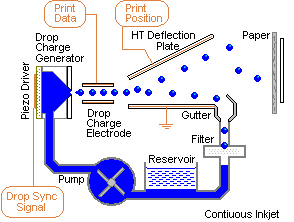| Continuous Inkjet Printers Printers > Inkjet > Continuous | Navigation Icons Guide
|
Continuous Ink Jet
Continuous ink-jet technology was developed by Carl Helmuth Hertz of Lund University and Richard Sweet of Stanford University in the 1960s.

A high pressure pump drives liquid ink from a reservoir into a microscopic nozzle, creating a stream of droplets. The droplets are given an electric charge, which can vary from drop to drop.
The stream of drops is basically aimed at a gutter which catches and ecycles ink, however alongside the direction of travel are one or more electostatic deflection plates. Changing the charge on a plate changes the travel of the droplets, and since each droplet has its own charge the esult is that they are individually aimed either at a target or into the gutter.
The droplets can be made more regular if the nozzle contains a piezoelectric crystal vibrating at regular intervals. The aim of droplets can be improved by separating charged droplets with uncharged guard droplets which are caught in the gutter and go round again.
Droplets are typically generated at a frequency of something like 75kHz to 150kHz so there is quite a high maximum print speed - although usually only a few drops are actually used. The pressure pump sets the distance travelled and how thinly the ink spreads - the drops are typically moving at 50 metres per second.
Continuous inkjets can use a great variety of inks. In most printers the ink is conductive but it can carry coloured pigments and ketone or alcohol carriers so the ink can dry quickly and be very long lasting. Non conductive inks carrying triboelectic charges are a possibility.
Obviously air currents and electrostatic fields on the objects to be printed can affect the travel of a continuous inkjet stream so it tends to have a resolution of just 50 -200dpi. Crude text is the typical output.
Continuous inkjet is widely used for marking and coding products comming off production lines - the long travel of dots makes it capable of printing on things like irregular packaging. The high speed of the process allows it to be used for mass-mailing and to a limited extent for personalisation - but the low quality is a limitation.
At low speeds modified drop-on-demand inkjet cartridges such as the HP "St Helens" model will be simpler - they don't need pumps and high voltages.
The noise of pumps, high voltages for deflection and the volatile solvents suggest that continuous inkjet isn't likely to be used in domestic or office environments. IBM intended its 4640 printer for word processing environments. It might conceivably find applications in fields like personalised clothing and vehicle spraying that currently tend to use wax and vinyl transfers.
There sould be potential in micromanufacturing, particularly if the esolution were improved. The continuous inkjets capacity to deliver a lot of material might prove very useful in quickly building the framework of an item.
--
© Graham Huskinson 2010
This page is like all those in the "book" section in being under development.
If you think this page is wrong in some respect or have better information on how things are done let us know. Click here.



